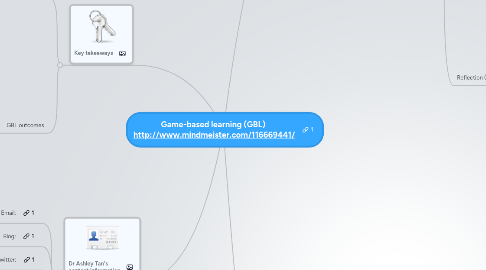
1. Your understanding of GBL
1.1. AM session
1.1.1. Promotes self exploration
1.1.2. Promotes self-directed learning
1.1.3. Promotes discovery
1.1.4. Fun elements engage learners
1.1.5. Appeal to all senses
1.1.6. Experiential
1.1.7. Able to absorb information better
1.1.8. Memorable and impressionable
1.1.9. Simulates reality
1.1.10. Can engage in roleplay
1.1.11. Learners participate actively
1.1.12. Can be addictive
1.2. Reflection (AM)
1.2.1. More fun than traditional instruction
1.2.2. More participation than traditional instruction
1.2.3. Learners are actively engaged
1.2.4. Can promote group-based learning
1.2.5. Promote teamwork
1.2.6. Can provide opportunities for peer mentoring
1.2.7. Provides context to practice skills, apply knowledge
1.2.8. Games and peers provide immediate feedback
1.2.9. Safe environment to make experiment, make mistakes
1.2.10. Confidence building
1.3. PM session
1.3.1. Learning in a fun way
1.3.2. Doing away with dinosaur methods
1.3.3. Interactive - 2 way comms with peers and content
1.3.4. Internalise content through hands on
1.3.5. Proactive way to learn
1.3.6. Multisensory learning: Enhance content retention
1.3.7. No age restrictions
1.3.8. Understanding learners: Trainees have the passion & interest in games
1.4. Reflection (PM)
1.4.1. Video gamea are interactive and addictive (very engaging)
1.4.2. Dynamic: Scenarios and problems change in real time
1.4.3. Promotoes self-discovery, self-directed learning
1.4.4. Mistakes are okay
1.4.5. Helps to connect knowledge with application
1.4.6. Learning at own place and pace
1.4.7. Opportunities for learners to be mentors or instructors
1.4.8. Lack of human touch (interaction is not traditional)
1.4.9. Might provide consistent experiences (remove subjectivity)
2. Key takeaways
2.1. Design elements
2.1.1. Providing meaningful contexts
2.1.2. Promoting systemic thinking
2.1.3. Microburst learning; interstitial time
2.1.4. JIT over JIC
2.1.5. Making challenges just out of reach
2.1.6. Providing immediate feedback
2.1.7. Leveraging on emotions
2.1.8. Flipping instruction
2.1.9. Reflecting after and around gaming
2.1.10. Apply GBL principles in non-game contexts
2.2. GBL outcomes
2.2.1. Productive failure
2.2.2. Perspective-taking
2.2.3. Delayed gratification
2.2.4. Persistance
2.2.5. Learning-by-doing; "muscle memory"
3. Resources
3.1. Prezi presentation
3.2. Mobile component
3.2.1. QR codes used in this seminar
3.2.2. QR code creators
3.2.2.1. Kaywa
3.2.2.2. QRstuff
3.2.3. QR code readers
3.2.3.1. i-nigma (for various smartphones)
3.2.3.2. QRafter (for iPad 2)
3.2.4. Google Form
3.2.5. Google Form results
3.3. Resources on GBL
3.3.1. GBL: What it is, why it works & where is it going?
3.3.2. GBL: Video games and good learning
3.3.3. Gee's 36 GBL principles
3.3.4. Other curated readings
3.3.5. Interview with Gee
3.3.6. Research on GBL
3.3.7. List of games played at the MxL
3.3.8. Horizon Report for K-12 2011
3.3.9. Bloom's revised taxonomy, affective and psychomotor frameworks
